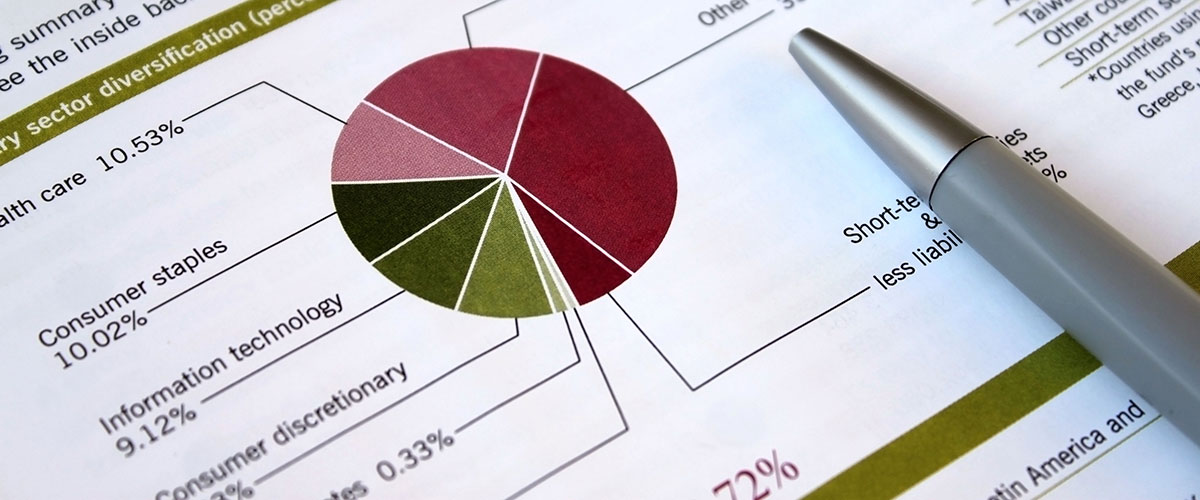Stock Market Sectors

What is a Stock Market Sector
A stock market sector is a broad grouping of industries and companies that have the same economic characteristics. In simple terms, companies in a common sector have a lot in common.
How Many Market Sectors
There are 11 major market sectors, as defined by the Global Industry Classification Standard (GICS), that most investment managers and investors will monitor and use for investment purposes. A sector is further broken down into sub-categories or specific industries, which allows for a more defined and closer grouping of similar businesses.
A company is assigned to a specific industry based upon its main line of business, as measured primarily by revenue. In situations where a company has more than one major and different business activity, the company is classified based upon where most of the revenues and profits are generated.
Benefit of Market Sectors
Stocks are categorized into market sectors to make it easier to compare companies that have similar business models. Each sector has its own benefits, characteristics and considerations. An investment manager can target a specific sector or they can manage a portfolio that includes multiple sectors.
Market sectors make it easier to compare which stocks may be best to monitor within a sector. It is useful in helping to make informed decisions about what investments to select, especially when there is a desire to manage a portfolio to a specific market weighting.
List of Market Sectors
Communications Services Sector
Companies in the communications services sector are businesses that keep us connected through fixed-line networks or wireless access. They are also companies that provide us content, such as information, advertising, entertainment, news and social media. Examples of the communication services sector stocks include Alphabet (GOOG), AT&T (T), Comcast (CMCSA), Facebook (FB), Twitter (TWTR) and Verizon (VZ).
Communications Services stocks provide exposure to internet stocks with a higher growth profile as well as exposure to a diverse mix of defensive telecom companies. Companies in the sector are generally sensitive to economic cycles.
The communications service sector consists of 5 industries.
List of Industries in the Communication Services Sector
- Diversified Telecommunication Services
- Wireless Telecommunication Services
- Entertainment
- Media
- Interactive Media & Services
Consumer Discretionary Sector
Companies in the consumer discretionary sector are businesses that produce non-essential goods and services which are more sensitive to economic cycles. The demand will fluctuate based upon general economic conditions and the business cycle. These companies are also referred to as consumer cyclical companies. Examples of the consumer discretionary sector stocks include Amazon (AMZN), Denny’s (DENN), Hasbro (HAS), McDonald’s (MCD) and Starbucks (SBUX).
Consumer Discretionary stocks perform well at the beginning of a recovery, when interest rates are low, but can lag during economic slowdowns, which illustrates how the performance is closely related to the health of the overall economy.
The consumer discretionary sector consists of 11 industries.
List of Industries in the Consumer Discretionary Sector
- Automobile Components
- Automobile
- Distributors
- Diversified Consumer Services
- Hotels, Restaurants & Leisure
- Household Durables
- Leisure Products
- Multiline Retail
- Specialty Retail
- Textile, Apparel & Luxury Goods
- Internet & Direct Marketing
Consumer Staples Sector
Companies in the consumer staples sector are businesses that sell products considered necessary and essential to life. Since they are less sensitive to economic cycles, they are also referred to as consumer defensive companies. Examples of the consumer staples sector stocks include Clorox (CLX), Coca-Cola (KO), General Mills (GIS), Phillip Morris (PM) and Proctor & Gamble (PG).
Consumer Staples stocks tend to be resistant to economic downturns due to the stable underlying demand for necessary goods and services, which is why it is viewed as one of the least volatile market sectors.
The consumer staples sector consists of 6 industries.
List of Industries in the Consumer Staples Sector
- Beverages
- Food & Staples Retailing
- Food Products
- Household Products
- Personal Products
- Tobacco
Energy Sector
Companies in the energy sector are businesses that source, drill, extract and refine the raw commodities that we use to produce or supply energy products, such as oil and gas. Examples of the energy sector stocks include Chevron (CVX), ExxonMobil (XOM), Halliburton (HAL) and Schlumberger (SLB).
Energy stocks tend to be sensitive to changes in consumer demand and the economy with its performance closely related to the price of commodities, such as oil and natural gas.
The energy sector consists of 2 industries.
List of Industries in the Energy Sector
- Energy Equipment & Services
- Oil, Gas & Consumable Fuels
Financials Sector
Companies in the financials sector are businesses that provide financial services to commercial and retail customers. Examples of the financials sector stocks include Aflac (AFL), Berkshire Hathaway (BRK-A), JPMorgan Chase (JPM), Goldman Sachs (GS) and MetLife (MET).
Financials stocks are sensitive to changes in the economy, monetary policy (interest rates) and regulatory policy, which is why they tend to perform better at the beginning of business cycles.
The financials sector consists of 7 industries.
List of Industries in the Financials Sector
- Banking
- Capital Markets
- Consumer Finance
- Diversified Financial Services
- Insurance
- Real Estate Investment Trusts (REIT)
- Thrifts & Mortgage Finance
Health Care Sector
Companies in the health care sector are businesses that are focused upon improving and healing human life. Examples of the health care sector stocks include Biogen (BIIB), Johnson & Johnson (JNJ), Merck & Co. (MRK), Pfizer (PFE) and UnitedHealth Group (UNH).
Health Care stocks perform better in the latter stages of a business cycle as stable demand can make the sector less sensitive to economic cycles.
The health care sector consists of 6 industries.
List of Industries in the Health Care Sector
- Biotechnology
- Health Care Equipment & Supplies
- Health Care Providers & Services
- Health Care Technology
- Life Sciences Tools & Services
- Pharmaceuticals
Industrials Sector
Companies in the industrials sector are businesses that provide commercial and industrial products, including manufacturers and distributors of capital goods. Examples of the industrials sector stocks include Boeing (BA), CSX Corp (CSX), FedEx (FDX), Lockheed Martin (LMT) and Union Pacific (UNP).
Industrials stocks perform better in the early-to-middle stages of a business cycle as their performance is more sensitive to economic cycles.
The industrials sector consists of 14 industries.
List of Industries in the Industrials Sector
- Aerospace & Defense
- Air Freight & Logistics
- Airlines
- Building Products
- Commercial Services & Supplies
- Construction & Engineering
- Electrical Equipment
- Industrial Conglomerates
- Machinery
- Marine
- Professional Services
- Road & Rail
- Trading Companies & Distributors
- Transportation Infrastructure
Information Technology Sector
Companies in the information technology sector are businesses that research, develop and distribute technology-based goods and services. Examples of the information technology sector stocks include Adobe (ADBE), Apple (AAPL), Microsoft (MSFT) and Oracle (ORCL).
Information Technology stocks offer some of the best growth potential but they also come with high risks. Information technology is the largest sector in terms of market capitalization and it is viewed as one of the most volatile market sectors.
The information technology sector consists of 6 industries.
List of Industries in the Information Technology Sector
- Communications Equipment
- Electronic Equipment, Instruments & Components
- IT Services
- Semiconductor & Semiconductor Equipment
- Software
- Technology Hardware, Storage & Peripherals
Materials Sector
Companies in the materials sector are businesses that discover, develop and process raw materials. The sector is also referred to as basic materials. Examples of the materials sector stocks include Alcoa (AA), Dow (DOW), Dupont (DD), International Paper (IP) and Vulcan Materials (VMC).
Materials stocks perform better during the mid-to-late stages of a business cycle as they are more sensitive to economic cycles. They are also sensitive to price fluctuations in metal commodities, such as gold, copper and steel.
The materials sector consists of 5 industries.
List of Industries in the Materials Sector
- Chemicals
- Construction Materials
- Containers & Packaging
- Metals & Mining
- Paper & Forest Products
Real Estate Sector
Companies in the materials sector are businesses that are involved in residential real estate, commercial real estate or industrial real estate. Examples of the real estate sector stocks include American Tower (AMT), Boston Properties (BXP), Prologis (PLD), Simon Property Group (SPG) and Vornado Realty Trust (VNO).
Real estate stocks can act as a hedge against inflation due to the tendency of real estate values to increase when inflation is increasing. In addition to strong growth potential, real estate stocks provide diversification in a portfolio due to lower correlations with other major asset classes.
The real estate sector consists of 2 industries.
List of Industries in the Real Estate Sector
- Equity Real Estate Investment Trusts
- Real Estate Management & Development
Utilities Sector
Companies in the utilities sector are businesses that provide basic amenities, such as water, sewage services, electricity, dams and natural gas. Examples of the utilities sector stocks include Consolidated Edison (ED), Duke Energy (DUK), Exelon (EXC), NRG Energy (NRG) and PG&E (PCG).
Utilities stocks are generally less volatile and pay relatively high dividend yields. It can be a defensive investment during a recession or economic downturn since stable demand for utilities make the sector less sensitive to changes in the economy.
The utilities sector consists of 5 industries.
List of Industries in the Utilities Sector
- Electric Utilities
- Gas Utilities
- Independent Power & Renewable Electricity Producers
- Multi-Utilities
- Water Utilities
Market Sector Classification
Market sectors can also be broadly grouped to indicate a general classification, which commonly uses a structure that combines market sectors into 3 defined groups.
Market Sector Classification List
- Sensitive Super Sector
- Defensive Super Sector
- Cyclical Super Sector
Sensitive Super Sector
A sensitive super sector is a grouping of market sectors that include Communication Services, Energy, Industrials and Information Technology. These are industries that rise and fall with the overall economy but to a lesser extent than cyclical industries. In general, the stocks in these industries have a beta close to 1.
Defensive Super Sector
A defensive super sector is a grouping of market sectors that include Health Care, Consumer Staples and Utilities. These are industries that are relatively immune to economic cycles. In general, the stocks in these industries have a beta of less than 1.
Cyclical Super Sector
A cyclical super sector is a grouping of market sectors that include Materials, Consumer Discretionary, Financials and Real Estate. When the economy is prosperous, these industries tend to expand and when the economy is in a downturn, these industries tend to shrink. In general, the stocks in these industries have a beta of greater than 1.













